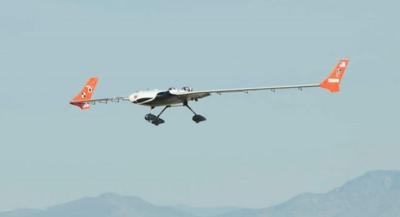Research UAV Helping Advance Aeroservoelastic Technology
Researchers at NASA’s Armstrong Flight Research Center, Edwards, California, successfully conducted the agency’s first flight of the X-56A Multi-Utility Technology Testbed (MUTT) on April 9. The 20-minute flight marked the beginning of a research effort designed to yield significant advances in aeroservoelastic technology using a low-cost, modular, remotely piloted aerial vehicle. Aeroservoelasticity involves the interaction of an airplane’s automatic flight controls with the response of non-rigid structures to aerodynamic forces. The X-56A is being flown in support of NASA’s Advanced Air Transport Technology (AATT) project’s Higher Aspect Ratio Wing subproject, Performance Adaptive Aeroelastic Wing element.

This was the first of eight planned Stiff Wing Controller Development (SWCD) envelope clearance flights. Successful efforts by the test team saw the X-56A attain an altitude of 4,000 feet above sea level and cleared for flight at up to 70 knots calibrated airspeed. Gary S. Martin, AATT associate project manager for integrated testing declared, “The flight went nearly exactly as rehearsed in the simulator.”
The latest in a long series of experimental research aircraft, or X-planes, the X-56A was built by Lockheed Martin’s Advanced Development Projects division in Palmdale, California, under a contract from the U.S. Air Force Research Laboratory (AFRL), Wright-Patterson Air Force Base, Ohio. Powered by twin 85-pound-thrust JetCat P-400 micro jet engines, the airplane has a semi-flying-wing configuration with winglets at the tips. Lockheed Martin constructed two airframe center-bodies along with several sets of wings because plans called for tests involving both stiff and flexible airfoils.
The maiden flight of the first airframe – nicknamed Fido – in June 2013, by Lockheed Martin and AFRL initiated testing to explore technologies for active flutter suppression and gust-load alleviation for new kinds of lightweight, flexible aircraft. The second airframe – dubbed Buckeye – arrived at Armstrong on June 2, 2014. Three low-speed taxi tests were conducted in January 2015 and a medium-speed taxi test was accomplished in March. Buckeye’s initial flights will allow researchers to checkout aircraft systems, evaluate handling qualities, characterize and expand the airplane’s performance envelope, and verify preflight predictions regarding aircraft behavior. The results will inform planning for the next phase of testing.
Leveraging the AFRL-sponsored program affords NASA with a unique opportunity to obtain significant expertise in modeling, analysis, and control of real-world aeroservoelastic challenges. The agency’s effort includes participants from several NASA centers; engineers at Langley Research Center, Hampton, Virginia, and Glenn Research Center, Cleveland, Ohio, are involved with modeling and analysis while Armstrong and AFRL are responsible for flight-testing. Lockheed Martin also provides vital assistance and support.
Researchers believe the next generation of aerospace vehicles will pose serious challenges to designers’ ability to model, predict, and control potentially destructive aeroservoelastic dynamics and to exploit efficiency gains from lighter, more flexible structures. The use of real world flight systems such as the X-56A MUTT will impart unique knowledge and expertise that will benefit the development of such vehicles across all speed regimes.
(Image provided by NASA)
 ANN's Daily Aero-Term (05.29.25): Terminal Radar Service Area
ANN's Daily Aero-Term (05.29.25): Terminal Radar Service Area ANN's Daily Aero-Term (05.30.25): Very High Frequency (VHF)
ANN's Daily Aero-Term (05.30.25): Very High Frequency (VHF) Aero-News: Quote of the Day (05.30.25)
Aero-News: Quote of the Day (05.30.25) Airborne 05.23.25: Global 8000, Qatar B747 Accepted, Aviation Merit Badge
Airborne 05.23.25: Global 8000, Qatar B747 Accepted, Aviation Merit Badge ANN's Daily Aero-Linx (05.30.25)
ANN's Daily Aero-Linx (05.30.25)



